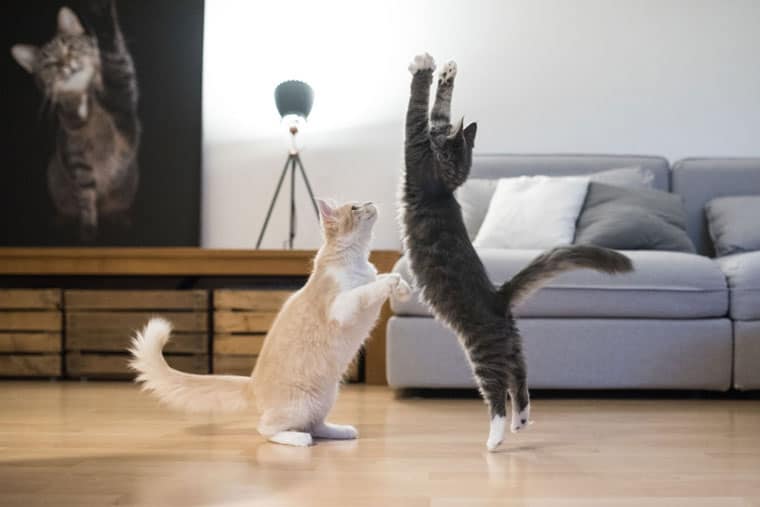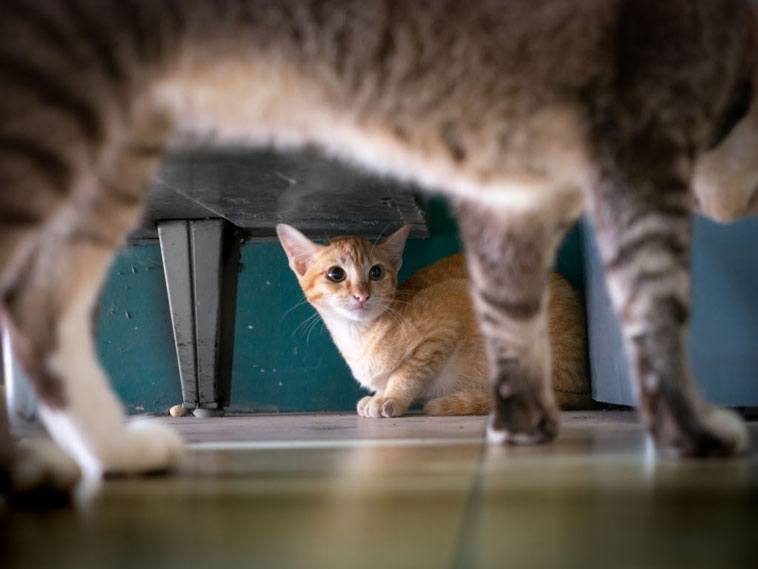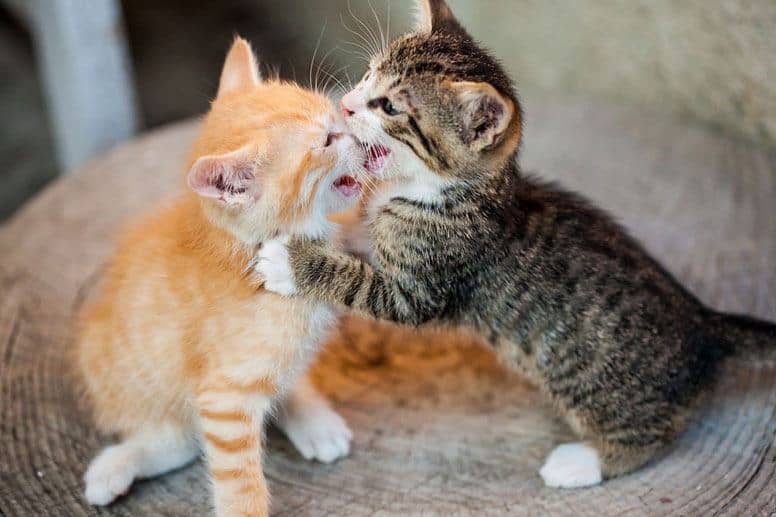Last Updated on 11/05/2020 by Veronica Jones
Cats are playful creatures throughout their lifetime. They’re willing to chase, bat at, or wrestle with anything, including you and each other. This will ring true if you’ve ever made a midnight trip to the bathroom only to have your ankles viciously attacked in the darkness. While a friendly wrestling match between your kitties may look a little rough, for cats it’s not always about play. They are also fierce defenders. They’ll fight to protect their territory, their clan (including you), and themselves. When the fur starts flying, how do you tell if your cats are playing or fighting?
To truly know whether your cats are playing or fighting, you need to have a basic understanding of cat body language. While the rolling around, biting, and even the sounds may seem similar between playing and fighting, there are some definite differences to look for. Cats that are playing will show restraint, be more relaxed, and know when to quit; cats that are truly fighting will be tense, deliberate, and determined.
The Ways That Cats Play

Even if your kitty has never spent a night out, they still have primal instincts to hunt and protect themselves and their territory. Play fighting is a domestic cat’s way of acting on those instincts without the necessary need. Because of this, many of the actions of playing and fighting are the same, but the intensity of playing should be a little more mellow. While there are kitties with a competitive streak that take their play to the extreme, it still won’t reach the levels of a real cat fight.
When cats are playing, their body is more relaxed. Their ears will be forward, their hair won’t be raised and they will lean into each other. Claws and teeth are usually left out of play fights as the idea isn’t to hurt anyone. Kittens, on the other hand, may try a little tooth or claw out of curiosity of because they just don’t have control over these weapons yet.
Playful kitties will usually go swing for swing, with each allowing the other one their fair share of swats. They’ll turn the other cheek, so to speak, and take a couple of hits instead of seemingly fighting for their life. They may chase each other, then take a short break and switch roles.
Cats that are playing are usually relatively quiet. This isn’t to say there won’t be some meowing or rattling of the furniture when things get crazy. But there usually isn’t any hissing or growling unless someone accidently gets a little aggressive.
All playing between cats ends with some social grooming and more than likely a communal nap. No hard feelings are felt and everyone is satisfied with a job well done, ready to do it again later.
What a Cat Fight Looks Like

When cats fight, on the other hand, it’s usually a noisy affair. There will be lots of hissing, growling, and howling usually as a buildup to the main event. There may then be screaming as angry cats start to bite and use their claws. Ears will be pinned down flat, the hair along their backs and necks will stand on end and their tail will look like you blow dried it backwards. Your cat’s body will be tense or rigid, and their tails will switch angerly back and forth. Cats that are fighting will usually lean away from each other as if to protect their face.
One cat is usually the bully when fighting, and will be the one chasing and taking more of the swats. The other cat may cower, try to run, or just crouch to protect themselves. There are no rules when cats fight and some can get downright dirty. Look for biting and clawing without restriction, even if one cat is waving the white flag.
After a fight, cats will avoid each other like grade school kids believing the other has cooties. There will be no snuggling, grooming, or even looking at each other. The aggressor in the fight may come out and about, while the victim may hide or choose to streak through the house from safe place to safe place.
How Should You React to Your Cats Playing or Fighting?
We all know that cats are going to do what they want whether we approve or not, so what does it matter if you can tell the difference between cats that are playing or fighting? Well, knowing what for sure is going on will help you know whether a tussle is going to end up with your cats licking each other’s faces or if you should intervene before fur starts to fly.
For cats that are playing, let ‘em at it. Play fighting is important for physical and emotional development in kittens, and a great way for adult cats to burn off excess energy. As long as things aren’t getting too aggressive and both parties are enjoying themselves, let your cats play as much as they want.
If your cats are fighting, it’s best to break them up so that one doesn’t end up hurting the other. This doesn’t mean that you go rushing in there feeling like a hero. Rather, try to break it up from a distance first by making a loud noise, slamming a door, or yelling to try to get their attention. If that doesn’t work, try to put something between them, like a couch cushion or piece of cardboard. Something that is sturdy enough to block their paw shots and big enough so that your fingers don’t come out of it bloody and scratched. Cat scratches and bites can be a serious issue for both humans and cats alike, so be sure to protect yourself and prevent injury if possible.
Consider keeping your cats with their ill feelings separated from each other until they’ve had a chance to cool down and then supervise their next get-together. For frequent fighters, consider baby gates to keep things separate and make sure there are plenty of resources to go around (ie. food, water, and litter boxes), so that sharing doesn’t become one of the instigators.

